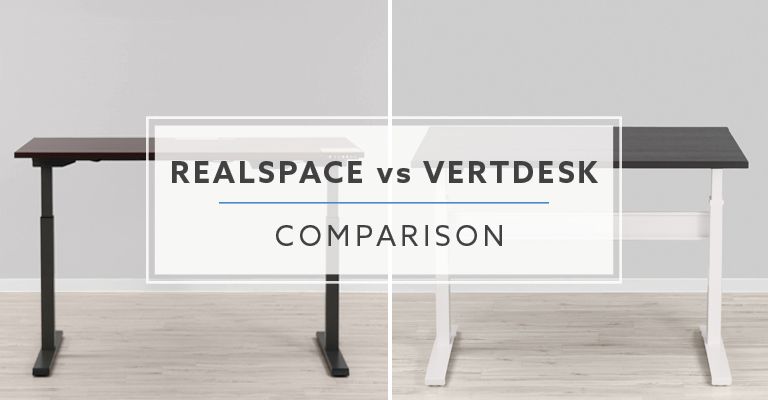Today we are going to be taking a look at two popular electric standing desks from the mid-range. The Realspace Magellan found exclusively at Office Depot and OfficeMax stores and our own VertDesk v3 found at BTOD.com. While each of these electric standing desks is operated by the push of a button, they are actually quite different products. This post should help to show you those differences and allow you to make the best buying decision.
Full Disclaimer: We are an office furniture dealer and sell some of the products we review. To learn more about the products we sell, our review process and why you can trust us, please visit: Why we’re different. Who is BTOD.com and The Breakroom Blog?
Realspace Magellan vs. VertDesk v3
– OEM Manufacturer
– Where Are Components Made?
– 2024 Pricing
– Assembly
– Specs / Features
– Stability
– Electronics
– Weight Capacity Testing
– Motors / Gears / Glides
– Frame and Feet
– How They Operate
– Return Policy and Warranty
OEM Manufacturer
The OEM manufacturer for the Realspace Magellan electric standing desk is HI-MAX INNOVATION, LTD. I was not able to find an extensive amount of information on this company.
Like many of the other standing desk brands available online, BTOD does not actually manufacturer the VertDesk. We work with a US based OEM manufacturer, K&A Mfg., Inc.; a company we’ve done business with for over 12 years. They are the manufacturer of RA Products, which includes the premium NewHeights standing desk brand. I am personally a little biased towards their products and standards because the owner of K&A also happens to be my father, Bill Knighton. He has been in the industry for thirty years and continues to set a high bar for quality.
Where are the components made?
| Realspace Magellan | VertDesk v3 | |
| Frame | Taiwan | Taiwan |
| Electronics | Taiwan | Hungary |
| Gears | Taiwan | Germany |
| Assembly | Taiwan | USA |
2024 Pricing
| Realspace Magellan | VertDesk v3 | |
| 30” x 60” Frame Only | n/a | $750.99 |
| 30” x 60” Laminate | $399.99 | $912.99 |
| 30” x 60” Hardwood | n/a | $1,753.99 |
Assembly
Overall, the assembly for each of the desks was easy enough that most could accomplish the task. While there were more bolts to assemble the Realspace Magellan, I would give it a slight advantage for ease of assembly without the use of a hex rod.
The assembly process was straightforward, with no issues getting the Realspace Magellan desk together. While there are a lot of bolts required to complete assembly, each was properly labeled in individual bags. If you are only building the desk and not adding accessories, you should have no issues using a hand screwdriver. With threaded metal inserts in the surface, the allen wrench provided and your own personal screwdriver will be enough to complete the task. The only component that requires you to screw into the particleboard surface was the programmable switch. The two holes for the switch assembly were pre-drilled and easy to screw into.
The VertDesk v3 is fairly straight forward as well, albeit not quite as easy as the Realspace. With the upper supports and feet pre-assembled to the columns, it cuts down on some of the assembly time. The biggest hang-up we’ve found for some customers is the installation of the hex rod. Sliding the hex rod into the motor side isn’t difficult, but some customers have encountered issues with the opposite leg. Since the launch of our VertDesk v3 we have started to include a wrench tool to assist with the process. This has made the process easier, but some users will still have a hang-up here. While the assembly process for a VertDesk v3 takes me about 12 minutes, most will be closer to the 30-90 minute time frame.
Standard Specs/Features
| Realspace Magellan | VertDesk v3 | |
| Button Options | Programmable button | Standard up/down push button |
| Lifting Capacity | 200 lbs. | 275 lbs. |
| Motor(s) | Dual | Single |
| Adjustment Range | 30” to 47” | 27” to 47.5” |
| Adjustment Speed | .41” per second | 1.55” per second |
| Soft Start – Stop | Yes | Yes |
| Auto-dark LED Display | n/a | Yes (one-touch programmable) |
| Leveling Glides | .5” adjustment | .5” adjustment |
| Expandable Frame | n/a | n/a |
| Anti-collision | No | Yes (Gyrosense) |
| Overload Protection | No | Yes |
| Frame Material | Steel | Steel |
| Foot Material | Steel | Steel |
Stability of Each Desk
The stability of a standing desk is one of the most important things to consider. An example is when you’ve been to a restaurant with a wobbly table. The distraction from that movement is enough to lose focus on a conversation while out for dinner or drinks. Now consider how this could affect your work, potentially losing focus with the task at hand during your day. Unfortunately, standing desk stability issues can’t be fixed with a stack of napkins, they need to be engineered to prevent instability. How much movement impacts your efficiency will vary, but our tests give you a good idea of how each of the standing desks will compare to each other.
Front to Back: During the rocking test we found the VertDesk v3 to be significantly more stable than the Realspace Magellan desk. With movement issues starting at 30”, the Realspace Magellan was one of the worst-performing desks we’ve tested. The VertDesk v3 was solid through most of the adjustment range, with some motion starting at 46”. As the desk rose to the max height of 47”, the motion was more noticeable and if you’re taller than 6’3” it could be a problem.
Left to Right: The wobble test had similar results. The VertDesk v3 being the more stable option. The Realspace Magellan performed slightly better for the wobble test, with motions starting at about 33”. By 36”, this motion became bad and would likely impact your work. The VertDesk v3 was solid through all heights, with little motion experienced at 47” tall.
Note: It’s very important, with all adjustable standing desks, to fully tighten all hardware. If there is hardware that is not completely tight, the movement experienced when extended to standing height will be exaggerated.
Electronics Comparison
Both the Realspace Magellan and VertDesk v3 desks feature smart control boxes. Each is a single board design engineered specifically for use in electric standing desks.
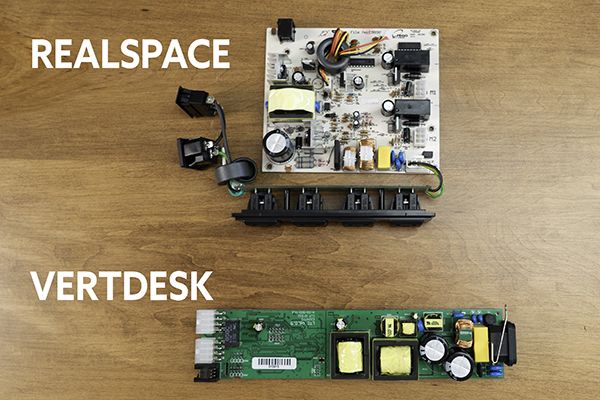
The Realspace Magellan was nice and clean, with the first square-shaped control box that I have seen. The Magellan board was built on a two-layer PCB board. This was the first desk that I have tested that was manufactured in Taiwan. The board was clean throughout, without excessive amounts of caulk used to hold components in place. The toroid cores were wrapped consistent throughout. Overall, I was impressed with the quality of the control box from the Realspace Product.
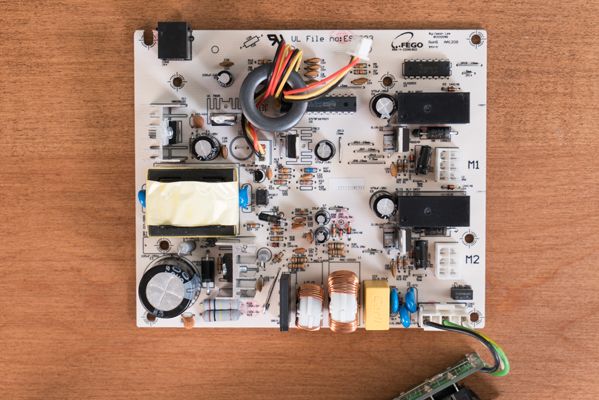
The Realspace control box came with a bonus. Integrated into the control box were four grounded plugs and two powered USB plugs. For a low-cost desk, this was a nice touch and users with few plugs might be able to solve all power needs through this solution. At the very least it provides a way to daisy chain additional power strips underneath the desk for more power requirements.
A downside to the Realspace Magellan standing desk electronics was the lack of overload protection and collision avoidance. Both of these features are something that I feel should come standard on all electric standing desks. Without overload protection, you run the risk of breaking internal components. The lack of collision avoidance is a safety concern for a desk that comes standard with one-touch functionality.
The VertDesk v3 also included a clean circuit board, with a more traditional rectangular shape. Built on a four-layer PCB board, our OEM is better able to maximize the surface area, while maintaining a smaller footprint. When looking at the bottom of the board, you can see there are a lot more components on the backside of the board. When taking a closer look at the larger components, each is held in place with solid stands and soldered to the board. This creates a good connection that doesn’t require unsightly caulk found on some of the alternative mid-range desks.
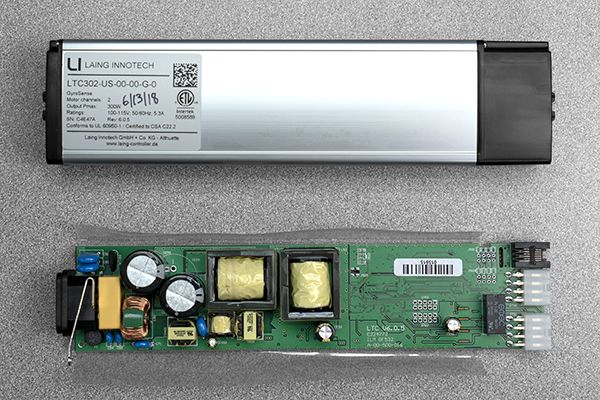

The VertDesk v3’s control box features overload protection, container stop and soft collision avoidance. It is the only desk in the mid-range category to feature all three of these functions standard. With Gyrosense technology, we are able to utilize an internal gyro sensor to better detect soft collisions. The alternatives in the category only feature collision avoidance systems for hard impacts. These are designed for collisions with items like furniture.
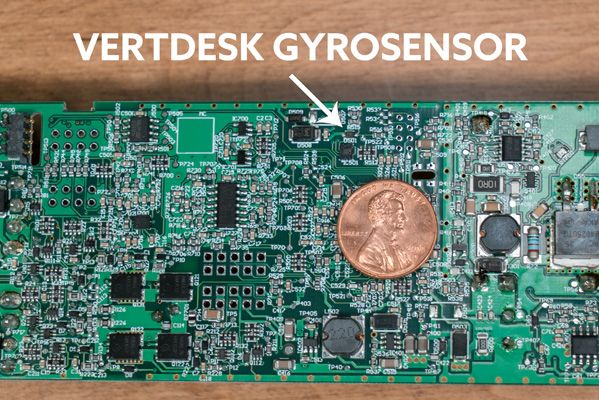
Weight Capacities and Testing
Through testing, we were able to verify that each desk was at the minimum able to lift the rated capacities.
The Realspace Magellan standing desk comes standard with a 200 lbs. weight capacity. The Magellan was able to lift the various loads we attempted up to the max capacity. The only concern being was how slow the desk was through all testing. With only the weight of the surface, the Magellan operated at an average speed of .42” per second. When fully loaded, the speed dropped down to .33” per second. The desk was able to exceed the max capacity with the lack of an overload protection system in place. Based on how poorly the desk did with normal loads, we wouldn’t recommend overloading the desk.
The VertDesk v3 comes standard with a 275 lbs. weight capacity. The VertDesk v3 was also able to lift the various loads we tested up to the max capacity. With a normal operating speed of 1.55”, the VertDesk v3 was able to maintain this speed up to 200 lbs. loads. Once we crossed that mark the desk started to slow down slightly, with an adjustment speed of 1.35” at max capacity. Because overload protection is in place, we were unable to load the desk beyond this mark.
Motor Comparisons
The motor systems on the Realspace Magellan and VertDesk v3 were quite a bit different. With the Realspace featuring two fully internalized motors and the VertDesk v3 one external motor.
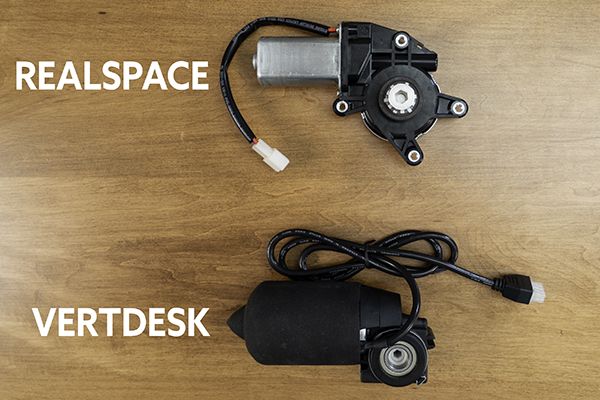
The motors on the Realspace Magellan standing desk were the smallest that I have seen on any electric standing desk. When compared to the single motor on the VertDesk v3, they were tiny. This is likely one of the reasons why the Realspace desk has such a slow lifting speed. I wasn’t able to learn too much about the motor used on this desk, as the part numbers didn’t bring up much information online.

Looking at the quality of the motor system, they have done a nice job fully internalizing the worm drive and gear system. This helps to keep contaminants out of the important areas, extending the life cycle of the product. The wires going into the motor were clean and I didn’t see any problems here either. Overall, like the rest of the Realspace desk, the motors were clean and passed the eye test.
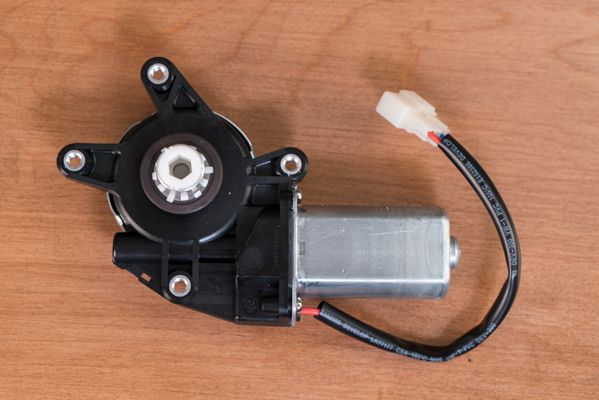
The VertDesk v3 motor is significantly larger; almost four times the size in fact. This isn’t much of a surprise after seeing how these two desks performed. The VertDesk v3 operated more than three times as fast, with 75 lbs. additional capacity. A good post to read would be the Single vs Dual Motor: Which is Better? These two desks are a great example of how single motor systems can be better than dual-motor systems.
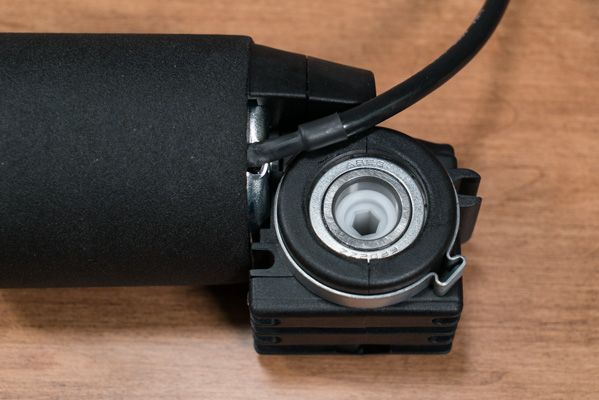
The large, single motor on the VertDesk v3 is built by German manufacturer Ketterer. Founded in the early 1800s, Ketterer was first known for manufacturing high-quality gear systems for clocks. By the 1970’s they saw the opportunity for manufacturing components for vertical adjustment. The motor used in the VertDesk v3 fully internalizes the worm drive and gear system in a custom encasement. The gear system utilizes two bearings for improved efficiency.
Gear Comparisons
Both desks featured single-stage gear systems, with the VertDesk v3 offering about 3” of additional, overall travel. Both of the gears were clean, but the overall quality of the gear in the VerDesk v3 was better.
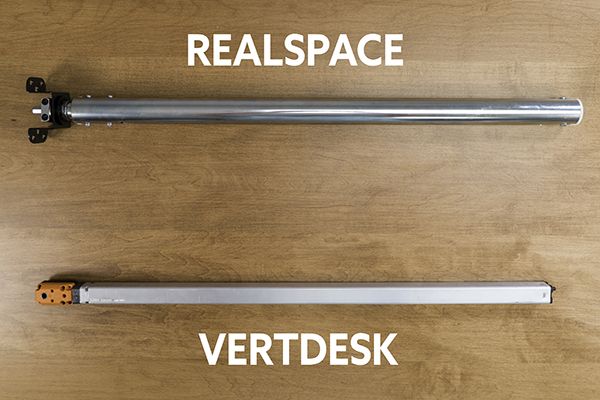
Looking first at the Realspace Magellan desk, the internal gear system was nice looking. This is a tough trade-off from other less expensive alternatives made in China though. While it was clean, it was not well made and there were some glaring issues. The most glaring was how unstable that spindle was inside the support tube. As you pulled out the gear, the gear wobbled back and forth in the tube. In was so bad that the gear actually scraped the inside of the support tube. The wobble created an inconsistent motion and made it difficult to manually move the gear. This likely played a part in the slowness of the adjustment speed.

The VertDesk v3, on the other hand, features gears from Ketterer, the same company producing our motors. Manufactured through the process of cold rolling steel, the gears in the VertDesk v3 were clean and efficient. While any company can use the cold rolling process, Ketterer’s attention to detail and years of experience give them a clear advantage. When manually moving the gears, the difference in quality from the Realspace product was obvious.
Glide Comparisons
Glide systems inside an electric standing desk are a key component of the entire system. These small plastic components provide the proper fit between the metal tubes, creating a stable frame. Glides also act as a natural lubricant, allowing the metal tubes to slide easily as the desks are adjusted. Over time plastic glides will begin to break down and can create binding issues. These binding issues can be a nightmare for anti-collision functions in an electric standing desks’ control box. Binding ultimately triggers false positives that can mimic collisions and cause the desk to stop moving up or down.

When manufacturers like Realspace fail to include a collision-avoidance system, my thought is they are doing so to avoid future binding issues. When opening the Magellan columns, the glide systems in place were not high quality and only reinforced this. We have heard of manufacturers having to recall 1,000’s of desks because of this issue and at this price point, it is easier to not include collision avoidance.
The glide system on the Realspace standing desk had such poorly fit glides that there was play in the columns at the lowest position. There was so much play that the desk had bad rocking motions at the lowest height. While binding won’t be an issue for this desk, stability problems definitely were. This is exactly why custom-fit glides are required to properly marry the two columns together. The one size fits all approach is never a good solution for metal tubes that have natural variances in size.
The VertDesk v3 features custom-fit glides on the top and bottom sections of the columns. These glides are made from Delrin Acetal by Dupont. This type of plastic was designed specifically for applications where low friction and high durability is required. This material is the preferred choice amongst the leading manufacturers of electric standing desks. Because Delrin is used, minimal lubricant is required. After a lifetime cycle test, that included 21,375 full up/down cycles, we can verify the durability of the glides. With minimal wear, the VertDesk v3 was able to remain stable throughout most heights.
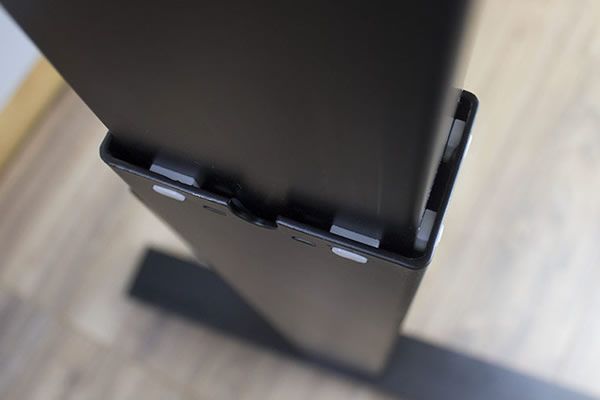
Frame and Foot Comparison
The frame and feet on both the Realspace and the VertDesk were well put together. Each had nice welds throughout with consistent paint finish as well.
Looking closer at the Realspace Magellan foot, rectangular tubing was used which created a clean look with the seam not visible. This design created the need for a plastic end cap for the feet that would have the potential to break over time as they are kicked by users in the office. The columns were well put together with clean paint throughout and a well hid the seam. The upper frame was consistent as well, with strong welds.

My only concern with the upper frame was the long pieces were only run parallel to the desk surface. There needs to be a frame component added running perpendicular to these to counteract wobble motion. Because these frame pieces are not included, motion can be seen in the upper frame when the desk is wobbled.
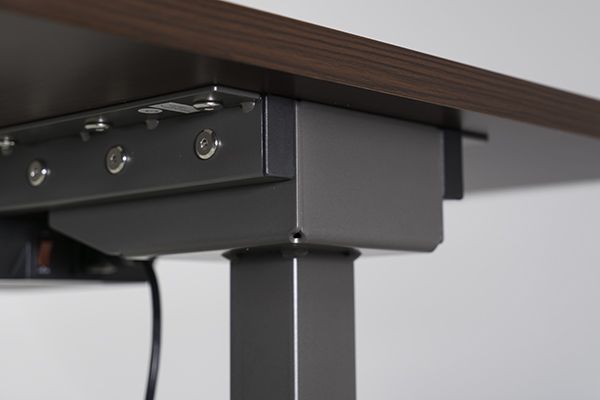
The VertDesk v3 featured a more traditional design with respect to the foot construction. With a top and bottom formed piece of steel, welded together to create a rigid foot. Moving up the columns, the VertDesk v3 had a nice paint finish as well, with a clean seam in the steel tubing that blends well with the finish. The upper supports and feet on the VertDesk v3 frame are permanently connected with welds. This creates a strong connection that is not able to loosen over time.

The steel tubing used for the columns on the VertDesk v3 was slightly thicker than the Realspace Magellan. This creates a stout frame that helps to minimize swaying that is commonly found on standing desks when raised to tall positions.

How Do They Operate
Both the Realspace Magellan and VertDesk v3 are push-button operated, with a soft start and stop mechanism. The Realspace Magellan is one of the most basic electric standing desks that we have tested to date. With minimal technology in the control box, there is the option to set programmed heights, but that is about all. The VertDesk v3 features a more robust set of functionality, with standard features like Gyrosense collision avoidance and overload protection. Container stops are available to custom program the range of your desks minimum and maximum height settings as well.
Without a collision-avoidance system on the Realspace product, the one-touch functionality included with their programmable switch is a major liability. We have demonstrated in the video below the amount of power found in the Realspace product. When the one-touch button is pushed, the desk has no issues breaking through two pencils.
The VertDesk v3’s Gyrosense technology does a better job at reacting to these types of collisions. It is also designed to better detect soft collisions; like fingers, hands and legs. While the Gyrosense technology is a safer alternative, we still highly recommend be cautious while using the one touch functionality.
Frame Colors
The Realspace Magellan is available in silver. The VertDesk is available in silver, black and white.
Optional Upgrades
| Realspace Magellan | VertDesk v3 | |
| Programmable Button | Standard | $49 |
| Grommet | n/a | $15/each |
| Locking Casters | n/a | $49/set |
| Wire Management Kit | n/a | $68 |
Return Policy
The Realspace Magellan can only be exchanged or returned for a full refund if unassembled within 14 days of purchase. You have 30 days to return the VertDesk, but you are responsible for the return shipping costs. We require that you hold onto the original packaging for all returns.
Warranty
| Realspace Magellan | VertDesk v3 |
| Five year warranty for everything on the desk. | Five year warranty on the electronics. 10 years on the non-electronic components desk (gears, surface and frame) |
Bottom Line
With the option to test drive before you buy, the Realspace Magellan is one of the few desks that can be found in a showroom around the USA. Priced under $500 with a desk surface, it is also one of the most affordable options available. Of course, you generally pay for what you get, and the Realspace Magellan is not an exception to this rule. The VertDesk v3 is about 20% more expensive but will feature better components throughout. If stability is a major concern, the VertDesk v3 is one of the most stable desks we have tested. If you have room in your budget, the VertDesk v3 is likely the better option.


